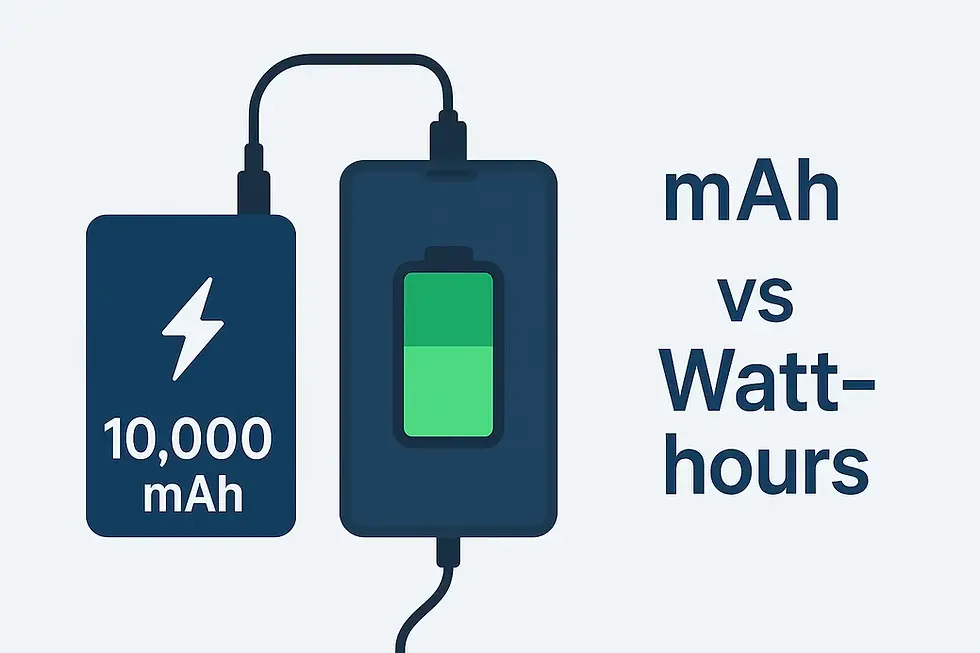Power Bank | mAh vs Watt-Hours: Real Capacity Explained
- Kalyan Bhattacharjee

- Jun 23
- 3 min read

Introduction
When your phone battery dips into the red, a power bank can be a lifesaver. But not all power banks are created equal, and terms like mAh, watt-hours, and real capacity can be confusing.
In this blog, we’ll break down what these terms mean and how to choose a power bank that truly meets your needs.
What Does mAh Mean in Power Banks? 🔋
mAh stands for milliampere-hour — the most commonly advertised rating on power banks. It measures the battery’s capacity, or how much charge it can store.
For example:
A 10,000 mAh power bank can theoretically charge a 3,000 mAh smartphone battery about 2.5 to 3 times, considering conversion loss.
However, mAh only tells part of the story, especially when different devices run at different voltages.
Watt-Hours (Wh): A More Accurate Measure ⚡
Unlike mAh, watt-hours (Wh) take voltage into account and provide a better idea of the actual power delivered.
💡 Formula: Wh = (mAh × Voltage) ÷ 1000
So if a 10,000 mAh power bank operates at 3.7V, it provides: (10,000 × 3.7) ÷ 1000 = 37 Wh
This is more useful when comparing power banks or checking airline safety limits (usually up to 100 Wh is allowed in carry-on).
Real Capacity vs. Advertised Capacity 🧮
Here’s the catch — the advertised mAh is based on the internal battery voltage (3.7V), but your device charges at 5V or higher.
Due to:
Voltage conversion
Heat dissipation
Circuit inefficiencies
You lose 15–30% of the energy. So your 10,000 mAh bank may only deliver 6,500–7,000 mAh effectively at 5V.
How Many Times Can It Charge My Phone? 📱
Let’s break it down with an example:
Your Phone Battery: 4,000 mAh
Power Bank (real output): ~6,800 mAh (after conversion loss)
👉 Your phone can be charged once fully and a second time up to ~70% before the power bank is empty.
Quick Charging & Output Ratings Matter 🔌
Beyond just mAh, look for output specs like:
5V/2A or 5V/3A (standard fast charge)
USB-C PD (Power Delivery) for laptops and modern phones
QC (Quick Charge) 3.0/4.0 support
These determine how fast and compatible the power bank is with your devices.
Air Travel with Power Banks ✈️
Most airlines allow power banks below 100 Wh in your carry-on bag. Check the Wh rating before you fly. A typical 10,000–20,000 mAh power bank is usually within safe limits.
Quick Buying Tips 💡
Feature | What to Look For |
Capacity (mAh) | 10,000–20,000 mAh for daily users |
Output | At least 2A, preferably with USB-C PD |
Input | USB-C input for fast recharging |
Build Quality | Reputable brand + overcharge protection |
Weight & Size | Balance between portability and power |

Conclusion ✅
Understanding how mAh, Wh, and real-world efficiency play into your power bank’s performance will help you make a smarter buying decision. Don't just go by the biggest number on the box — look under the hood and consider how it fits your charging needs, speed expectations, and travel habits.
battery capacity explained, power bank output and efficiency, convert mAh to watt-hours, portable charger specs, charging power bank, smartphone charging capacity, lithium-ion battery basics, power bank mAh, watt-hours, real capacity, power bank guide, power bank buying tips, portable charger power bank, best portable phone charger, usb battery pack, difference between mAH and watt-hours, how to calculate mah and watt hours, fintech shield







Comments